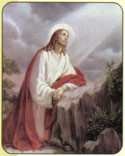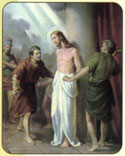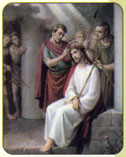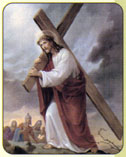 After
the Last Supper, Christ took the apostles to the Garden of Gethsemane to pray
because He knew what was coming the next day. He was afraid. He felt the weight of all of the sins of the
world.....past, present, and future. His
agony was so great that He sweat blood.
Under extreme anxiety, the capillaries on the surface of the skin
break. Our Lord prayed: "Abba, Father, all
things are possible to you. Take this cup away from me, but not what I will
but what you will" (Mark 14:36).
May we likewise accept the will of God and trust in Him, no matter
what happens. We know that He
will be with us and take us through any cross.
After
the Last Supper, Christ took the apostles to the Garden of Gethsemane to pray
because He knew what was coming the next day. He was afraid. He felt the weight of all of the sins of the
world.....past, present, and future. His
agony was so great that He sweat blood.
Under extreme anxiety, the capillaries on the surface of the skin
break. Our Lord prayed: "Abba, Father, all
things are possible to you. Take this cup away from me, but not what I will
but what you will" (Mark 14:36).
May we likewise accept the will of God and trust in Him, no matter
what happens. We know that He
will be with us and take us through any cross.

“Then Pilate took Jesus and had him scourged” (John
19:1). It was brutal. The Roman whip had three or four strands of
leather with pieces of bone and/or lead pellets attached to the end. Thus each blow tore globs of skin from our
Lord's back, causing blood to splatter and profuse bleeding. According to the evidence on the shroud,
Christ received not the normal 100 lashes, but 120.......60 by one soldier on
his back and another 60 by a shorter soldier who whipped below. When
Jim Caviezel was twice accidentally lashed with the whip during filming of the
“Passion of the Christ”, the pain was so intense that he could neither breathe
nor talk for a moment or two. Other
options are to read and reflect on Isaiah 53:4-6; Matthew 27:25-26; Mark
15:1-15; and Luke 23:16.

“And
the soldiers wove a crown out of thorns and placed it on his head, and clothed
him in a purple cloak (to signify
royalty), and they came to him and said, ‘Hail, King of the Jews!’ And they
struck him repeatedly (putting a reed in His right hand as a scepter and
even spitting on Him). Once
more Pilate went out and said to them: ‘Look, I am bringing him out to you, so
that you may know that I find no guilt in him.’
So Jesus came out, wearing the crown of thorns and the purple cloak. And
he said to them, ‘Behold, the man!’ When
the chief priests and the guards saw him they cried out, ‘Crucify him, crucify
him!’ Pilate said to them, ‘Take him yourselves and crucify him. I find no
guilt in him” (John 19:2-6).
The soldiers probably pounded the crown into our Lord's skull. Christ the King, the King of the Universe is mocked and suffered such humiliation for our sins. Indeed, the shroud shows numerous puncture marks on our Lord's skull. Other options include reading and reflecting on Psalm 69:8-22,31-35; Isaiah 52:13-15; 53:1-3; Matthew 27:27-31; Mark 15:16-20; John 15:18-20.
The soldiers probably pounded the crown into our Lord's skull. Christ the King, the King of the Universe is mocked and suffered such humiliation for our sins. Indeed, the shroud shows numerous puncture marks on our Lord's skull. Other options include reading and reflecting on Psalm 69:8-22,31-35; Isaiah 52:13-15; 53:1-3; Matthew 27:27-31; Mark 15:16-20; John 15:18-20.
1) When we are criticized and even condemned publicly,
may we act with a calm dignity, grace, love, and faith in God as Christ did
before Pilate while trusting in His Father. Wisdom 2:12-22;
Matthew
26:57-68; 27:11-26; Mark 14:53-65; 15:1-15; Luke 22:66-23:25; John 18:19-24;
28-40; 19:1-16.
2)
As Christ
accepted His cross, may we accept our daily crosses and offer them up to the
Lord (John 19:17).
3)
(3rd, 7th,
& 9th Stations) Each
time that we fall, may we have the perseverance to pick ourselves up and keep
going on while learning from each fall.
The shroud shows evidence of extensive bruises that would be
caused by falls. Any time that we fall
into sin, may we get up quickly, say a prayer of sincere sorrow, and go to
confession as soon as possible if serious. Most spiritual directors recommend
monthly confession to facilitate growth in virtue. St. John Paul II went
to confession every week.
4)
Mary
accompanied her son on the entire way of the cross, suffering together with Him
the whole time with intense love, tenderness, dignity, strength, and grace,
trusting in the will of the Father in His plan for our salvation and knowing
that the glory of the resurrection will come. May these qualities motivate us
to embrace Mary as our mother. (Genesis 3:15; Lamentations 2:13)
5)
May we be
willing to help others carry their crosses as Simon of Cyrene helped our Lord
to carry His cross (Matthew 27:32;
Mark 15:20-22; Luke 23:26).
6) (6th
& 8th Stations) May we have the compassion
of Veronica and the women of Jerusalem (Luke 23:27-31). When we help the least of these, we do it
for Christ as Veronica did. (Matthew 25:37-40).
Other
options include Isaiah 50:4-7; Matthew 27:32-33; Mark 15:20-22); Luke 23:26-33;
John 19:16-17.

Every
breath was excruciating because Christ had to lift himself up against the nails
to breathe or utter a word. Even from
the cross, our Lord tried to teach us.
Let us examine these lessons from the seven times He briefly spoke as underlined.
1)
"Father, forgive them; they know not what
they do" (Luke
23:34). May we forgive as Christ did
on the cross.
2)
The good
thief said: "Jesus, remember me when you come into your kingdom."
He replied to him, "Amen, I say
to you, today you will be with me in Paradise" (Luke
23:39-43). Christ showed his mercy to
the good thief in his last moments. May
we also show mercy to others.
3)
“Standing by
the cross of Jesus were his mother and his mother's sister, Mary the wife of
Clopas, and Mary of Magdala. When Jesus
saw his mother the disciple there whom he loved, he said to his mother, ‘Woman, behold, your son.’ Then he said to the disciple, ‘Behold,
your mother.’ And from
that hour the disciple took her into his home” (John 19:25-27).
Thus Christ gave us himself in the Eucharist on Holy Thursday;
salvation on Good Friday; and even His mother from the cross. Later when the centurion pierced the dead
redeemer's side and heart with his lance, some speculate that was the very
moment when Mary's heart was pierced by a sword as prophesized by Simeon some
33 years earlier (Luke 2:35).
4)
After
this, aware that everything was now finished, in order that the scripture might
be fulfilled, Jesus said, "I thirst.” (John 19:28). Our Savior ardently thirsts for sinners to come
back to Him.
5)
"My
God, my God, why have you forsaken me?" (Matthew 27:46; Mark 15:34-35). To not
feel the presence of His father was Christ's greatest suffering. May we always crave to feel the presence
of God even though He is always there.
6)
“It
is finished." And
bowing his head, he handed over the spirit (John 19:30). These last words
were of triumph. Christ accomplished His
mission from the Father and opened the gates of Heaven for us. May our deaths also be moments of triumph.
7)
"Father,
into your hands I commend my spirit"; and when he had said this he breathed his last
(Luke 23:46). May we also resign ourselves
to the will of God. With faith and trust
in God, all things work out for the best in the long run.
When
the soldier pierced the side of Christ, blood and water flowed out (John
19:34). They symbolize the blood of the
Eucharist and the purifying water of Baptism.
Doctors have written articles on the
medical aspects of the Christ's passion and can only conclude that He had tremendous
endurance and superhuman strength to bear it all and stay alive for as long as
He did. See www.evangelicaloutreach.org/crucifix.htm, www.ldolphin.org/kwells9.html,
www.frugalsites.net/jesus/crucifixion.htm, www.ethoughts.org/crucifixion_description.htm. These meditations can also
be found on Blog #78 at paulrsebastianphd.blogspot.com for a
direct click. For meditations on the
Joyful, Luminous, and Glorious Mysteries, go to Blogs # 50, 73, and 84 at
paulrsebastianphd.blogspot.com.
God allowed
this scandalous travesty to happen for a higher good......to make reparation
for our sins and thus make possible our salvation and eternal happiness in
heaven. He loved us so much with such
great mercy that He sent his only begotten son to save us from our sins and
spiritual death and open the gates of heaven for us. May we
remember that suffering will make saints out of us if accepted as Christ did
and united with His cross as we offer it all up to God for the Church, the
missions, a better world, and for our loved ones.
Other options are to read and reflect
on Psalm 16:9-10; 22:2-3, 7-20; 30:2-6; 31:2-6, 10-16; Isaiah 52:13-53:12;
Matthew 27:34-66; Mark 15:23-47; Luke 23:33-56; John 3:13-21; 19:18-42; Romans
5:19; Philippians 2:6-11; Hebrews 4:14-16, 5:7-9; 1Peter1:17-19; 2:19-25.


No comments:
Post a Comment